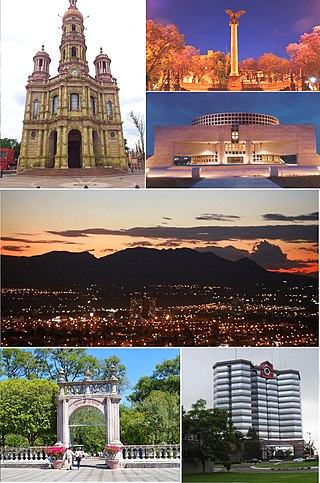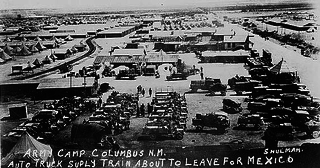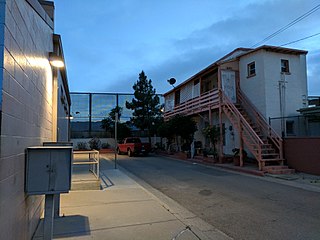
El Paso is a city in and the county seat of El Paso County, Texas, United States. The 2020 population of the city from the U.S. Census Bureau was 678,815, making it the 22nd-most populous city in the U.S., the most populous city in West Texas, and the sixth-most populous city in Texas. Its metropolitan statistical area covers all of El Paso and Hudspeth counties in Texas, and had a population of 868,859 in 2020.

Francisco "Pancho" Villa was a Mexican revolutionary and prominent figure in the Mexican Revolution. He was a key figure in the revolutionary movement that forced out President Porfirio Díaz and brought Francisco I. Madero to power in 1911. When Madero was ousted by a coup led by General Victoriano Huerta in February 1913, Villa joined the anti-Huerta forces in the Constitutionalist Army led by Venustiano Carranza. After the defeat and exile of Huerta in July 1914, Villa broke with Carranza. Villa dominated the meeting of revolutionary generals that excluded Carranza and helped create a coalition government. Emiliano Zapata and Villa became formal allies in this period. Like Zapata, Villa was strongly in favor of land reform, but did not implement it when he had power.

Aguascalientes is the capital of the Mexican state of the same name and its most populous city, as well as the head of the Aguascalientes Municipality; with a population of 948,990 inhabitants in 2012 and 1,225,432 in the metro area. The metropolitan area also includes the municipalities of Jesús María and San Francisco de los Romo. It is located in North-Central Mexico, which roughly corresponds to the Bajío region within the central Mexican plateau. The city stands on a valley of steppe climate at 1880 meters above sea level, at 21°51′N102°18′W.

Downtown El Paso is the central business district of El Paso, Texas.

KTSM-TV is a television station in El Paso, Texas, United States, affiliated with NBC and owned by Nexstar Media Group. The station's studios are located on Oregon Street in northwest El Paso, and its transmitter is located atop the Franklin Mountains on the El Paso city limits.

The Plaza Hotel, formerly the Hilton Hotel, is a landmark skyscraper located at 106 Mills Avenue in El Paso, Texas, USA.
Central El Paso is part of the city of El Paso, Texas, and contains some of the city's oldest and most historic neighborhoods. Located in the heart of the city, it is home to approximately 130,000 people. Development of central El Paso started around 1875, when the city was barely beginning to gain its roots.

Sunset Heights is a historic area in El Paso, Texas that has existed since the latter part of the 1890s. Many wealthy residents have had their houses and mansions built on this hill. Although some buildings have been renovated to their former glory, many have been neglected and have deteriorated. An organization, the Sunset Heights Improvement Association, helps neighbors on a fixed income to manage home maintenance and also sponsors an annual tour.

Manuel Gregorio Acosta (1921–1989) was a Mexican-born American painter, muralist, sculptor, and illustrator. His work received more recognition during the Chicano movement, and his portrait of Cesar Chavez was reproduced on the cover of Time magazine in 1969.

The Village of Columbus and Camp Furlong is a National Historic Landmark District commemorating the 1916 raid by Pancho Villa on the town of Columbus, New Mexico, and the American military response to that raid, the "Punitive Expedition" led by General John J. Pershing. The raid and its response, set during World War I, the Mexican Revolution, and an accompanying low-level Border War, played a significant role in diplomacy and military preparedness for eventual American entry in the World War. The district encompasses buildings that survived the raid, and military facilities used in the American response. The landmark designation was made in 1975.

Hotel Paso del Norte is a historic 351-room hotel. It is located in El Paso, Texas, less than one mile north of the international border with Mexico. The hotel originally opened on Thanksgiving Day 1912, and was designed by Trost & Trost. The building was added to the National Register of Historic Places on January 5, 1979. It recently underwent a complete and total renovation, and reopened its doors as part of Marriott's Autograph Collection on October 8, 2020.
Founded as El Paso del Norte by Spanish Franciscan friars at an important mountain pass, the area became a small agricultural producer though most settlement was south of the river where modern Mexico lies. The city was considered part of New Mexico under Spanish Conquerors and was tied economically to Santa Fe, New Mexico and the Chihuahuan mining districts of San Felipe El Real and San José del Parral.

The Mexican Border War, also known as the Border Campaign, refers to a series of military engagements which took place between the United States military and several Mexican factions in the Mexican–American border region of North America during the Mexican Revolution. It was the last major conflict fought on U.S. soil.

The Third Battle of Ciudad Juarez, or simply the Battle of Juarez, was the final major battle involving the rebels of Francisco "Pancho" Villa. It began on June 15, 1919, when Villa attempted to capture the border city of Ciudad Juarez from the Mexican Army. During the engagement the Villistas provoked an intervention by the United States Army protecting the neighboring city of El Paso, Texas. The Americans routed the Villistas in what became the second largest battle of the Mexican Revolution involving the US, and the last battle of the Border War. With the American army closing in, the Villistas had no choice but to retreat. Pancho Villa then attacked Durango but lost again, so he retired to his home at Parral, Chihuahua in 1920, with a full pardon from the Carrancista government.

Oscar Leeser is an American politician who has served as the 52nd mayor of El Paso, Texas since 2021. A member of the Democratic Party, he previously served as the 50th mayor from 2013 to 2017.

El Segundo Barrio is a historic Hispanic neighborhood in El Paso, Texas. It is one of the oldest neighborhoods in El Paso. It was one of the main ports of entry into the United States from Mexico for many years, and became known as the "other Ellis Island" as a result.

The El Paso Streetcar is a streetcar system in El Paso, Texas, that uses a fleet of restored PCC streetcars that had served the city's previous system until its closure in 1974. It opened for service on November 9, 2018. The system covers 4.8 miles (7.7 km) in two loops from Chihuahuita to Kern Place, serving Downtown El Paso and University of Texas at El Paso along the way. The system was constructed under the authority of the Camino Real Regional Mobility Authority, but when the major construction was completed, around spring 2018, it was transferred to Sun Metro, for operation and maintenance. In 2023, the system had a ridership of 130,600, or about 800 per weekday as of the third quarter of 2024.

Chihuahuita is a neighborhood in El Paso, Texas. It has also been known as the "First Ward." It is considered the oldest neighborhood in the city. It has also suffered through extreme poverty in its history. It is currently on the Most Endangered Historic Places list as compiled by the National Trust for Historic Preservation. It is located on the border of the Rio Grande at the Mexico–United States border. For most of the twentieth century, the name Chihuahuita was used to refer to all of southern El Paso, often including El Segundo Barrio. In 1991, Chihuahuita was designated as a historic district by the city of El Paso.
Pueblo is a term primarily used in Puerto Rico to refer to the municipal district (barrio) that serves as the administrative, historic and cultural center of a municipality. The concept of pueblo is often used locally as analogous to the concept of downtown in U.S. cities. Pueblos are officially called barrio-pueblo by the United States Census since 1990.

The Pershing House, historically known as Quarters Number 1, is a building at 228 Sheridan Road in the Fort Bliss Main Post Historic District at Fort Bliss in El Paso, Texas. It was built in 1910 and added to the National Register of Historic Places in 1987.

















